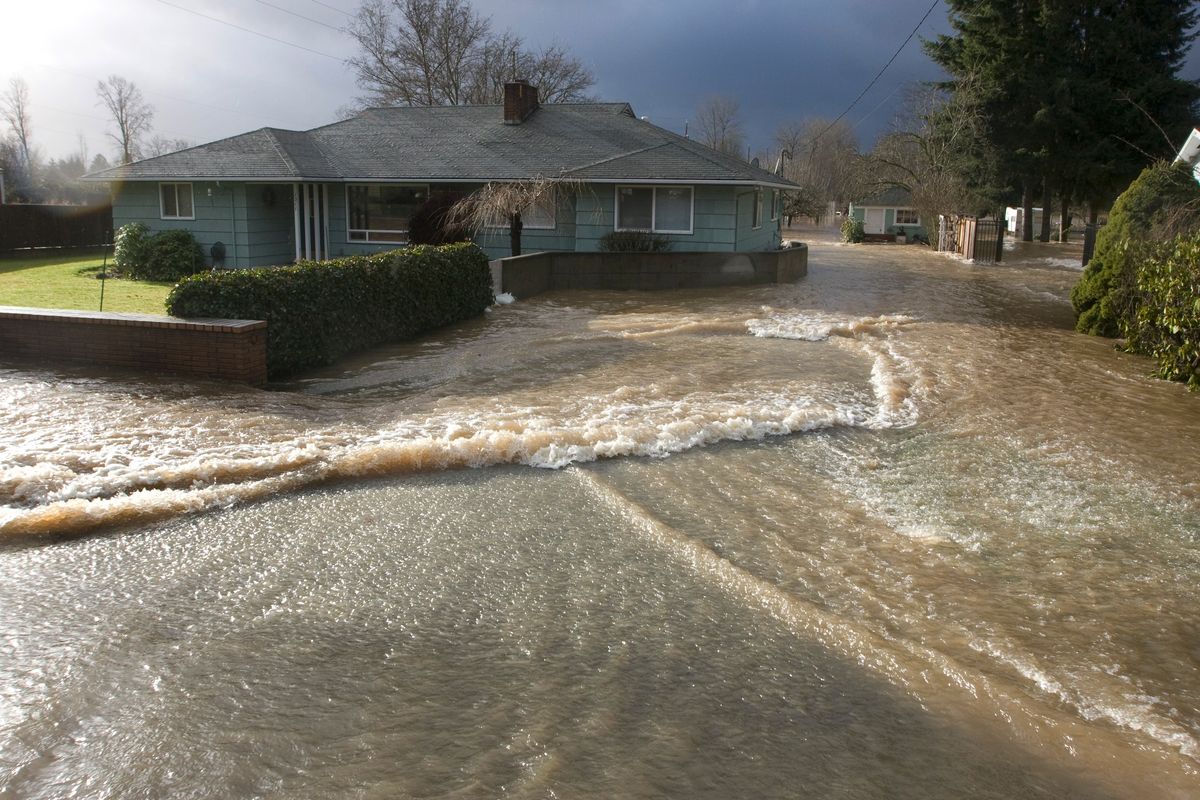West side flooding closes roads; Stevens Pass reopens
Workers scramble to remove a building log jam on the Puyallup River in Fife, Wash. as the swollen river continued its record swell on Wednesday Jan. 7, 2009. Incoming tide at the river's delta and continued rain worried officials that the river would top levees and flood neighborhoods in Fife and Puyallup, Wash. (Joshua Trujillo/Seattle Post-Intelligencer / Associated Press)
CENTRALIA, Wash. — Floods, mudslides and avalanches in the Pacific Northwest kept tens of thousands of people from their homes today, brought most freight trains to a standstill and stranded hundreds of trucks along the major highways that link Seattle’s busy ports with markets around the country.
The flooding — some of the worst on record in Washington state — was touched off by a combination of heavy rain of 6 inches or more and a warm spell in the mid-40s that rapidly melted snow in the Cascade Mountains.
A 20-mile stretch of Interstate 5, the state’s major north-south freeway, was shut down between Olympia and the Oregon line, with one section under 3 feet of water. Avalanches closed Interstate 90, which cuts east from Seattle through the Cascades, along with the two other routes through the mountains. Late this afternoon, highway crews reopened one of those cross-state routes, U.S. Highway 2 across Stevens Pass.
Amtrak service and most freight trains were stopped as well.
Hundreds of truckers pulled their rigs off onto highway shoulders or packed truck stops as the bad weather bottled up nearly all freight in and around Seattle, costing the economy untold millions of dollars of day.
“You can’t go north, you can’t go east, you can’t go south. What are my options?” Jon Amerman, a trucker from White Hall, Mont., said earlier Thursday, before Stevens Pass reopened. He had planned to head east to Yakima to pick up apples after delivering a load of goods to Seattle. He figured his company was losing more than $1,000 a day every day that he was idle.
More than 30,000 people in Western Washington were urged to evacuate their homes Wednesday in low-lying areas from Bellingham near the Canadian border to the Kelso area near the Oregon line as rivers spilled over their banks and flooded some neighborhoods.
The stricken areas included such far-flung Seattle bedroom communities as Fife, Orting and Snohomish, but Seattle itself saw little flooding.
By this afternoon, Orting officials told residents they could return to their homes.
Rescuers had used boats to evacuate scores of people from nursing homes. Fire trucks rolled through the streets, using loudspeakers to warn people to leave.
No serious injuries were reported.
“I think we’re seeing an all-timer, or as bad as anyone has seen,” said Rob Harper, a spokesman for the state Division of Emergency Management. “We just haven’t seen this extent of flooding.”
Many rivers were still rising today, though others began dropping as the heavy rain subsided and snowmelt lessened with falling temperatures.
State officials said the danger of avalanches would keep I-90 closed at Snoqualmie Pass at least until Friday, and I-5 would probably still be flooded over the weekend.
State Transportation Secretary Paula Hammond estimated the economic effect of just the I-5 shutdown at $4 million a day. A major storm 13 months ago closed the same stretch for four days.
Crews struggled to reopen highways, especially those leading to communities cut off by the flooding and avalanches.
In Orting, a town near Mount Rainier, Jamie Hicks used five pumps to try to clear the 2 1/2 feet of water from his house, about 50 yards from the swollen Puyallup River.
“We’re veterans at this,” Hicks said as his son rowed a boat in front of the house. “You just pump it out.”
In Snohomish, about 30 miles north of Seattle, a crowd watched as Robert Bishop and his roommates were rescued by boat from their two-story duplex. The home close to the Pilchuck River was nearly half underwater.
“I thought it was fine, but it went higher than I thought,” said Bishop, 48, who waited out previous floods. “It was very scary.”
Because of the closed highways, a truck traveling north from Portland to Seattle — normally a journey of about 175 miles — would need to take a lengthy detour. Ten thousand trucks travel I-5 each day, and an additional 7,000 move freight across the Cascades.
A spokesman for the Port of Seattle said it was too early to gauge the cost of the storm. In 2008, the port took in 1.7 million 20-foot containers from China, Japan, South Korea and elsewhere. Most of that freight leaves the port by rail.
No freight or passenger trains were moving between Seattle and Portland, but trains were making it across the Cascade Range. About 60 trains travel daily between Portland and Seattle carrying freight and passengers, said Gus Melonas, a spokesman for Burlington Northern Santa Fe.
Some of the north-south freight was being rerouted through eastern Washington until tracks can reopen, Melonas said.


















